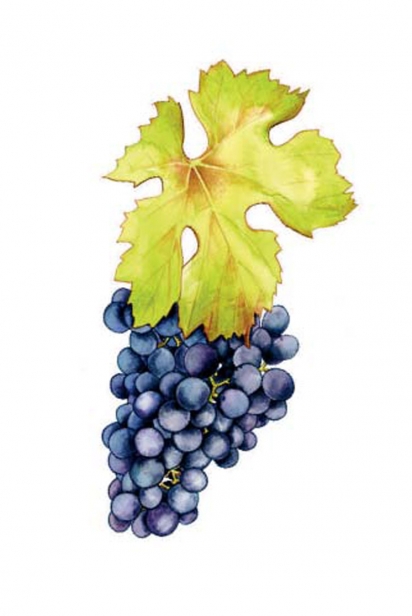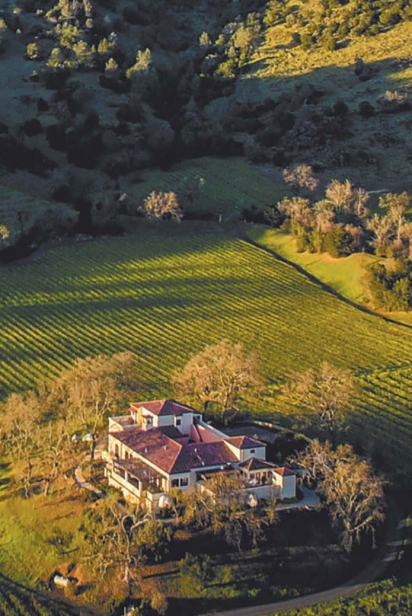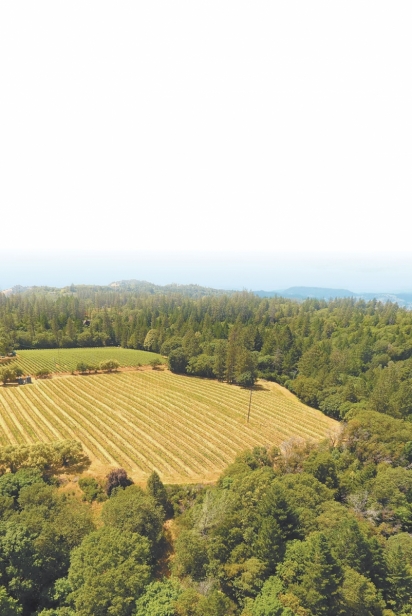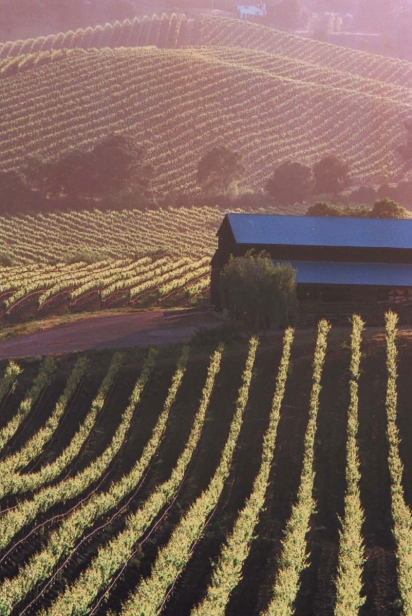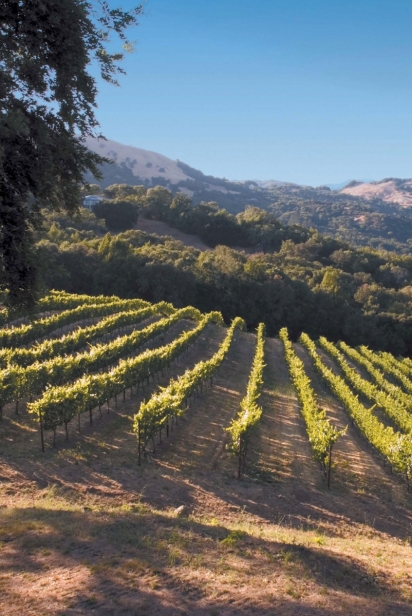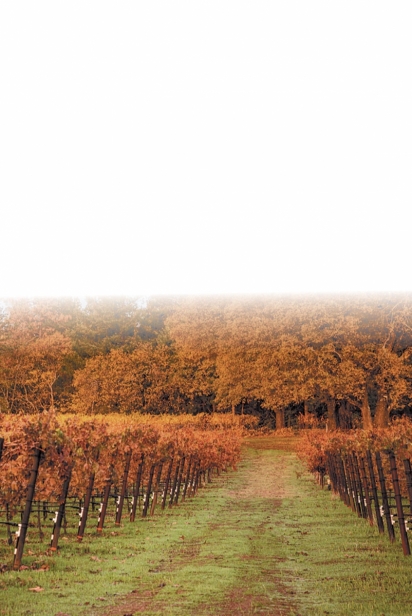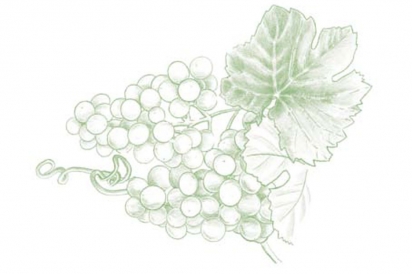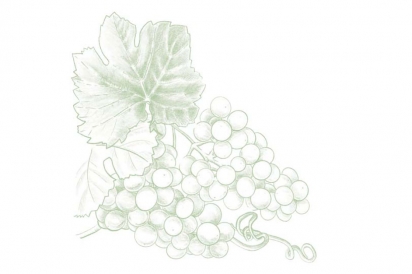Discover Napa’s AVAs
ILLUSTRATIONS BY CL AIRE LE MOING
Few words in the wine industry—uttered by sommeliers and shop owners or printed on bottle labels—inspire the sort of immediate recognition and respect as does the phrase “Napa Valley.” Relatively small, a mere 30 miles by five, it is a giant among winegrowing regions, not only in the United States but around the world.
It was Napa that challenged the superiority of the French in a 1976 taste-off—and won. It was Napa that led the charge in defeating the industry-threatening phylloxera insect plague. It was Napa that allowed for the sort of innovation and collaboration among vintners that propelled the region to thrive and excel, and it is Napa today that is helping to lead the fight against global climate change with the work of organizations like Napa Green as well as that of individual vintners and wineries throughout the Valley.
What makes Napa so magical, so prestigious, so pristine? In a word, it is the people—though those people will almost universally tell you that they are attracted by factors far beyond anything that can be wielded by humanity: stunning natural vistas, unparalleled fertility, a rare agrarian space in an otherwise overpopulated world, free of high rises and interstates, free of smog and noise pollution. It is the land, the same land that not long ago provided for the Onasatis people—known more commonly by the name Wappo—that today provides for the Valley’s more than 100,000 residents, most of whom are involved in the wine industry in one way or another.
Yet the thing that makes this land so special, so hospitable to grapevines and people alike, isn’t simply its stunning beauty. It is also the diversity of the soils that lie below the surface. It is believed that the Napa Valley, in the short distance between Mount St. Helena and the San Pablo Bay, possesses more than half of the soil types found in the entire world. Furthermore, despite its middling size, the Valley contains a vast array of complex microclimates. This diversity of climate and soils, combined with the spirit of the pioneers who first planted grapevines in this sacred riparian space, created a winegrowing region that immediately outpaced the most storied in the world both in the variety of what could be grown here and it the quality of the yield.
In 1981, the Napa Valley became the second American Viticultural Area (AVA) in the United States—having been explored, mapped and determined as unique to the satisfaction of the federal Alcohol and Tobacco Tax and Trade Bureau (TTB). (The first, in Augusta, Missouri, was established the previous year.) It quickly became apparent, however, that the Napa Valley contained multitudes of potential AVAs, and that to delineate those further would better represent the impressive complexity of the Valley’s soil types, microclimates, and the wines that came as a result. What followed in the decades to come was an attempt by those who live upon and love the land to better understand it, and to help outsiders do the same. While the Napa Valley remains an AVA, today it boasts 16 additional AVAs. But unique soil deposits and microclimates alone are insufficient to create an AVA. In the end, as ever, it is the labor of those who work the land that can delineate a space as an American Viticultural Area.
In every instance, an AVA was created because people who worked the land and recognized its uniqueness went out of their way to have it formally recognized. What follows is a quick glance at the 16 nested AVAs of the Napa Valley.
Atlas Peak AVA
Established 1992
The Atlas Peak AVA is located in the Vaca Mountains on the Valley’s eastern side, due east of Stags’ Leap AVA, in the southeastern quadrant of the Valley. With elevations reaching 2,600 feet, Atlas Peak is significantly cooler than the valley floor and comprised primarily of volcanic soil types. The area is considered ideal for growing Cabernet Sauvignon and Chardonnay, and by extension other Bordeaux and Burgundian varietals are also sometimes found planted here.
While many prominent producers source fruit from the region, Atlas Peak is also home to some truly excellent wineries, among them Kongsgaard Wine, Antica Napa Valley, Stagecoach Vineyard, William Hill Estate, and more.
Calistoga AVA
Established 2010
Calistoga, both an AVA and a historic and charming township, sits at the northernmost end of the Valley, away from the cooling effect of the San Pablo Bay, in the shadow of Mount St. Helena. Calistoga is known for stifling temperatures, natural hot springs and being slightly off the beaten path. A variety of loam, clay and silt are distributed throughout, partly by alluvial fans, and the area ranges from 300 to 1,200 feet in elevation with temperatures exceeding 100°F regularly in the summer months. Hearty grapes such as Zinfandel, Petite Sirah, Cabernet Sauvignon and more grow well in the Calistoga AVA.
Among the many noteworthy members of the Calistoga AVA are Chateau Montelena, whose 1973 Chardonnay bested Burgundian first-growths at the “Judgment of Paris” in 1976, as well as Dutch Henry Winery, Larkmead Vineyards, Storybook Mountain, Tamber Bey, Venge Vineyards, Tedeschi Family, and many more.
Chiles Valley AVA
Established 1999
Chiles Valley AVA is a slender stretch of fertile land at the top of the Vaca Range, between Lake Hennessey and Lake Berryessa from west to east, and between the Howell Mountain AVA and Atlas Peak AVA from north to south. Sparsely populated and stunningly beautiful, it gets cold at night, colder in winter, and vineyards in Chiles Valley— like most mountain AVAs—harvest significantly later than those on the valley floor. The soils are largely marine in composition, with clay and loam predominant, and elevations ranging from 600 to 1,200 feet. Bordeaux varietals such as Cabernet Sauvignon and Merlot grow well here, though some of the earliest plantings in the area were Zinfandel.
Originally part of Rancho Catacula, which was awarded to Joseph Ballinger Chiles, the area is so isolated that it is said that many of the vineyards in the area were spared from the phylloxera outbreak as a result. Among the noteworthy wineries are the Volker Eisele Family Estate, Brown Estate Vineyards and Nichelini.
Coombsville AVA
Established 2011
Napa’s youngest AVA is, of course, as old as the rest from a geological standpoint, though it was only recognized as an AVA a little over a decade ago—named for Nathan Coombs, who founded the city of Napa. With relatively little rain, around 25 inches annually, the well-drained volcanic soils and proximity to the cooling effects of the San Pablo Bay make Coombsville an ideal place to grow grapes and make them into wine. The AVA is located due east of Napa township, a stone’s throw from the river.
Wineries in Coombsville are numerous and have quickly made a name for themselves. Sciandri Family Vineyards, Palmaz Vineyards, Ancien Wines and many more have helped to set this young AVA apart, demonstrating the quality and diversity of the grapes that can be grown there, ranging from Cabernet Sauvignon to Pinot Noir and everything in between.
Diamond Mountain District AVA
Established 2001
At the far northwest end of the valley, in the Mayacamas nestled just north of Spring Mountain, the Diamond Mountain AVA has set itself apart. The elevations, reaching as high as 2,200 feet above sea level, help moderate the temperatures experienced on the valley floor. Here in the redwoods and evergreens of the mountains that separate Napa from the Pacific Ocean, the temperatures almost never reach 100° and the Cabernets can ripen late into the season, rooted deep into volcanic soils.
The AVA was established in large part thanks to the efforts of Rudy von Strasser of von Strasser Winery, and is also home to Schramsberg, the second-oldest commercial winery in Napa still in operation. Founded by Jacob Schram, Schramsberg was revitalized by Jack and Jamie Davies in the 1960s and today produces amazing sparkling wines. Castello di Amorosa, or “the castle,” and many other excellent wineries can also be found here.
NapaVintners.com/Napa_Valley/Diamond-Mountain-District-Ava
Howell Mountain AVA
Established 1983
The northernmost of the AVAs in the Vaca Mountains on the eastern side of the Napa Valley, Howell Mountain AVA includes the tiny town of Angwin and rests on shallow volcanic soils that enjoy significant amounts of sunlight and reasonable amounts of precipitation most years. Howell Mountain also provides some beautiful views from its eminent vantage.
Home to numerous exceptional wineries and coveted fruit, Howell Mountain is perhaps best known as the home of Randy Dunn and Dunn Vineyards, and is also home to such producers as O’Shaughnessey, Cade, Arkenstone, Robert Foley and La Jota. The annual Taste of Howell Mountain is held in June and is not to be missed.
Los Carneros AVA
Established 1983
Los Carneros is a low-lying AVA mostly near sea-level and close to the San Pablo Bay, below the protection of the mountains. This makes it an ideal place to grow Burgundian varietals, and while many have successfully endeavored to grow other grapes in the area, this is the lone place in the Napa Valley where Pinot Noir and Chardonnay rule.
Los Carneros also spans uniquely from Napa into Sonoma. The area is cool year-round with minimal rainfall, and the soils are predominantly clay. It is the only local AVA located entirely south of the city of Napa. Los Carneros is, in some ways, the gateway to the Napa Valley, and there are a significant number of excellent producers there. Among them Truchard—who, in addition to Pinot Noir and Chardonnay, have some exceptional blocks of Cabernet Sauvignon and Merlot—as well as Dearden Wines, Calmere Estate, Etude, John Anthony’s Church Vineyard, and many more are all worth checking out. Domaine Carneros is there too, if French-style bubbles, manicured gardens and massive chateaux are your thing—and in truth much of the Chardonnay and Pinot Noir vinted throughout the Valley is grown in this AVA.
Mount Veeder AVA
Established 1990
The Mount Veeder AVA, situated in the Mayacamas, sweeps along the western side of the Valley from just south of the city of Napa all the way to the township of Saint Helena, giving it one of the largest footprints of any AVA in the Valley. Cooler temperatures are seen as a benefit on Mount Veeder, as is the high elevation reaching 2,600 feet above sea level and the mountainous terrain. While these factors combine to offer low yields, the grapes grown on Mount Veeder are coveted and the Cabernets in particular seem to age almost indefinitely.
While the Mount Veeder Winery is one of the few who have endeavored to erect a winery in the untamed mountains of this AVA, it is widely planted to vineyards and many sought-after producers source fruit from the area.
Oak Knoll District AVA
Established 2004
The first AVA north of the city of Napa, the Oak Knoll District crosses Highway 29 in both directions and benefits from its proximity to the San Pablo Bay, often covered in fog that rolls in off the water. Cool temperatures are a feature of the area, and in places Oak Knoll is at sea level, never exceeding 800 feet of elevation. It is also home to a massive alluvial fan, and soil compositions vary but are generally gravelly and well-drained.
A wide variety of producers create a wide variety of wines in the region, though Bordeaux varietals and Chardonnay tend to be favored. As with so much of the Napa Valley, there’s far more Cabernet Sauvignon planted in Oak Knoll than any other varietal. Among the AVA’s many must-visit wineries, Trefethen Family Vineyards—whose Chardonnay won top honors at numerous blind tastings in the late 1970s— Monticello, Robert Biale, Matthiasson and Materra stand out. OkdNapa.com
Oakville AVA
Established 1993
Nowhere in Napa is the mantra “Cab is king” more true than in Oakville, where in 1966 Robert Mondavi famously opened the first new winery since the repeal of Prohibition. Oakville is the home of the famous To Kalon Vineyard. It was in Oakville that winemaker Nils Venge crafted the 1985 Groth Reserve Cabernet Sauvignon, the first American wine ever to earn 100 points (the 1969 Mondavi earned 99), and it is in Oakville that so many phenomenal Cabernet Sauvignons, including MacDonald, Paradigm, Tierra Roja, Tench, Saddleback, Ghost Block, Oakville Ranch and many, many more such small producers, craft phenomenal small-production wines that have captured the attention of the world. Other wineries often go far out of their way to source fruit from Oakville, where a ton of Cabernet Sauvignon grapes can cost more than a new car.
The magic of Oakville is in part a diversity of soil types and in part an enviable climate, with fog rolling in most mornings and evenings, helping the grapes retain acidity. The greater part of the equation, however, is the people who make the coveted grapes of Oakville into wine. They can be found grabbing coffee at the historic Oakville Grocery in the mornings, in the vineyards and wineries the rest of the time, and always eager to tell you what they love about their AVA.
Rutherford AVA
Established 1993
It may have been gold dust that attracted the first massive wave of pioneers to California, but in modern times the dust of Rutherford has challenged that of gold in terms of lore and prestige. Northwest of Oakville and approximately the same size, Rutherford, too, is known for Cabernet Sauvignon. Here, the fertile soils retain water and impart upon the grapes the coveted “Rutherford dust,” as it is called, a desirable and telltale feature of many of Rutherford’s finest wines that is best understood in terms of mouthfeel. In brief, the tannins are often exceedingly fine, smooth and “dusty” in texture.
Rutherford is the home of Beaulieu, where the legendary immigrant winemaker André Tchelistcheff crafted stunning wines and taught others to do likewise. Rutherford is also home to Grgich Hills, where the king of Chardonnay, Mike Grgich, opened his own phenomenal winery. So many others, including Honig, Pina, Peju, Round Pond, ZD, Staglin, Caymus, Inglenook and more, combine to make Rutherford a very special place indeed.
Saint Helena AVA
Established 1995
Saint Helena is a beautiful little town. The namesake of the AVA that surrounds it on all sides, the elevation and soil types vary widely while the daily temperature range is relatively consistent. Saint Helena is known primarily for Cabernet Sauvignon and Chardonnay. It was in Saint Helena that Cesare and Rosa Mondavi, the parents of Robert and Peter, were invested in the Sunny Saint Helena Winery, today Merryvale Vineyards, which sits immediately across Highway 29 from Taylor’s Refresher, today Gott’s Roadside. And it was in Saint Helena that Prussian immigrant Charles Krug established his eponymous winery, which the Mondavis purchased after Prohibition ended and which Peter’s side of the family still owns and operates today.
There are seemingly countless wineries of note in this storied and historic part of the Valley, from AXR to Ballentine, Calafia, Pellet Estate, Prager, Rombauer, Varozza, Spottswoode and Titus, just to name a few.
Spring Mountain District AVA
Established 1993
The Mayacamas Mountains shield most of the Napa Valley from the influence of the Pacific Ocean, but at 2,600 feet the Spring Mountain District feels the impact of the Pacific uniquely, and is thus cooler and often wetter than the rest of the Napa Valley. Still, Spring Mountain can be exceedingly warm and dry, especially in recent years, and the winemakers who favor the isolation and well-drained sedimentary soils of the area have had to become increasingly creative of late. Cabernet Sauvignon, Chardonnay, Merlot and Riesling have all been known to thrive on Spring Mountain, with Smith-Madrone’s Riesling being named the top Riesling in the world at the Olympiad du Vin in the late 1970s.
Spring Mountain’s isolation and high elevations have attracted winemaking pioneers since the 19<sup>th</sup> century, and still do to this day. Steep and narrow roads wind through stands of ancient redwoods high above the fog, offering some of the best views of the valley floor below. Producers such as Smith-Madrone, Keenan, Pride Mountain, Lokoya, Terra Valentine, School House, Sherwin Family and others define Spring Mountain with their unique and wonderful wines.
Stags’ Leap District AVA
Established 1989
The Stags’ Leap District is a low-lying AVA located due east of the Yountville AVA on the Silverado Trail in the foothills of the Vaca Range. Elevation varies only slightly, from sea level to around 400 feet, where rocky hillsides and volcanic soil compositions can be found. The area is named for an iconic stony outcropping, and most of the arable land is planted to Cabernet Sauvignon.
Warren Winiarski tasted Nathan Fay’s Cabernet Sauvignon here in the late 1960s and recognized the incredible potential, founding Stags’ Leap Wine Cellars shortly thereafter. Around the same time, Bernard Portet selected a nearby location for Clos du Val. Both wineries were selected by Steven Spurrier to be tasted in France in what came to be known as the Judgment of Paris in 1976. That year, Winiarski’s Stags’ Leap Wine Cellars was selected as the best red wine from a field that included numerous perennial French powerhouses such as Chateau Montrose and Chateau Mouton-Rothschild. A decade later, it was Clos du Val and Portet’s age-worthy Cabernet that took first place in a reenactment of the tasting, proving that Napa Cabs don’t just drink well young, they also age terrifically.
Wild Horse Valley AVA
Established 1988
Situated on the southern end of the Vaca Range on the rim of a caldera, the Wild Horse Valley AVA uniquely crosses from Napa County into Solano County. With elevations exceeding 2,100 feet above sea level, cooling winds, well-drained volcanic soils and close proximity to the San Pablo Bay, much of Wild Horse Valley is planted to Burgundian varietals, though a few producers do well with Bordeaux varietals as well.
Wild Horse Valley is sometimes overlooked, much to the detriment of those doing the looking. Here, Heron Lake, Enfield Wine and Kenzo Estate can be found and are indeed worth finding. The diversity of Wild Horse Valley and the wines made there are emblematic of the Valley as a whole. NapaVintners.com/Napa_Valley/Wild-Horse-Valley-Ava
Yountville AVA
Established 1999
Originally named Sebastopol by George Yount, the town of Yountville was renamed after its founder shortly after his death, and today is known for high-end shopping, fine dining and boutique hotels. The AVA surrounds the town on all sides, thus straddling the highway. Yountville never exceeds 200 feet above sea level, and fog rests gently on the vines most every morning. Sedimentary soils, a moderate climate, and limited rainfall combine to create a space ideal for growing Bordeaux varietals, though Chardonnay, too, is favored here.
George Yount planted the first grapevines in Napa in this location in 1836, on his land grant known as Rancho Caymus. Yountville is also home to a wide array of excellent wineries, ranging from Kapcsandy and Jessup Cellars to Gemstone and Dominus Estate. Yountville, both the town and the AVA, are must-visit places for visitors to the Napa Valley.
Looking to the Future
At present, a small group of advocates are seeking to establish approximately 4,000 acres called Crystal Springs as the Napa Valley’s 17<sup>th</sup> nested AVA. They’ll make their case in much the same way as others elsewhere: filling out the necessary paperwork with the government and gathering the data necessary to make the case that their space, too, with the eccentricities of the microclimate and soil types, constitutes a unique environment in which to grow grapes and make wine. The comment period for Crystal Springs closed this past May. Soon, the Napa Valley Vintners may be adding Crystal Springs to their map of Napa’s AVAs.
Will there be an 18<sup>th</sup> after that? A 19<sup>th</sup>? A 30<sup>th</sup>? How many microclimates indeed exist in this diminutive, fertile and bewitchingly beautiful valley? It is difficult to say. What is certain, however, is that each unique region—whether it is formally acknowledged as an AVA or not—is a piece in the puzzle that forms the Napa Valley, a piece that if it went missing would render the design incomplete. As it is with so many other things in the world, the Valley’s greatest strength is found in its diversity.
Mark Gudgel is a college professor, wine writer, genocide scholar, and marathon runner. His most recent book, The Rise of Napa Wineries: How the Judgment of Paris put California Wine on the Map, was released from History Press in 2023. Currently, he is working on two books: a guide to the Napa Valley and a study of Holocaust and genocide education in America.



